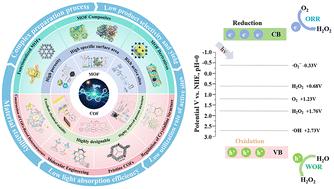mof和COFs光催化制备过氧化氢的研究进展
IF 9.2
1区 化学
Q1 CHEMISTRY, MULTIDISCIPLINARY
引用次数: 0
摘要
过氧化氢是一种广泛应用于工业、环境和能源领域的重要绿色氧化剂,金属有机骨架(MOFs)和共价有机骨架(COFs)在光催化合成过氧化氢(H2O2)方面显示出巨大的潜力。与传统的蒽醌工艺相比,光催化生产H2O2因其环保、可持续和高效的特点而受到人们的关注。本文综述了MOF/ cof光催化剂用于H2O2合成的最新研究进展,重点介绍了MOF/ cof光催化剂的催化机理、材料设计策略和性能优化方法。基于mof的功能化、复合结构和衍生材料已被证明在提高光催化活性方面是有效的,而COFs由于其可调谐的电子结构和高载流子迁移率而表现出优越的性能。此外,还讨论了MOF/ cof光催化剂制备H2O2的当前挑战和未来前景,旨在促进其工业应用。本文章由计算机程序翻译,如有差异,请以英文原文为准。

Research progress on photocatalytic production of hydrogen peroxide over MOFs and COFs
Metal–organic frameworks (MOFs) and covalent organic frameworks (COFs) have shown great potential in the photocatalytic synthesis of hydrogen peroxide (H2O2), which is an important green oxidant extensively used in industrial, environmental and energy applications. Compared to the traditional anthraquinone process, photocatalytic H2O2 production is gaining attention for its eco-friendly, sustainable and efficient characteristics. This review summarized the latest research progress on MOF/COF-based photocatalysts for H2O2 synthesis, focusing on their catalytic mechanisms, material design strategies and methods for performance optimization. Functionalization, composite construction and derived materials based on MOFs have been proven effective in enhancing photocatalytic activity, while COFs exhibit superior performance due to their tunable electronic structures and high charge carrier mobility. Additionally, the current challenges and future prospects of MOF/COF-based photocatalysts for H2O2 production are discussed, aiming to facilitate their industrial application.
求助全文
通过发布文献求助,成功后即可免费获取论文全文。
去求助
来源期刊

Green Chemistry
化学-化学综合
CiteScore
16.10
自引率
7.10%
发文量
677
审稿时长
1.4 months
期刊介绍:
Green Chemistry is a journal that provides a unique forum for the publication of innovative research on the development of alternative green and sustainable technologies. The scope of Green Chemistry is based on the definition proposed by Anastas and Warner (Green Chemistry: Theory and Practice, P T Anastas and J C Warner, Oxford University Press, Oxford, 1998), which defines green chemistry as the utilisation of a set of principles that reduces or eliminates the use or generation of hazardous substances in the design, manufacture and application of chemical products. Green Chemistry aims to reduce the environmental impact of the chemical enterprise by developing a technology base that is inherently non-toxic to living things and the environment. The journal welcomes submissions on all aspects of research relating to this endeavor and publishes original and significant cutting-edge research that is likely to be of wide general appeal. For a work to be published, it must present a significant advance in green chemistry, including a comparison with existing methods and a demonstration of advantages over those methods.
 求助内容:
求助内容: 应助结果提醒方式:
应助结果提醒方式:


